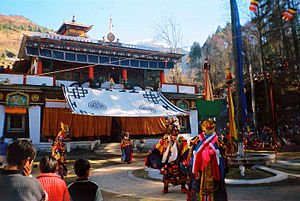Losar
Losar (Tibetan: ལོ་གསར་, Wylie: lo-gsar) refers to the Tibetan New Year, which is one of the most important festivals in Tibetan Buddhism. The Tibetan New Year is marked on the 1st to 3rd days of the first lunar month in the Tibetan calendar. This usually falls within late February or early March on the Western calendar. Traditionally it is a time for family gatherings, visiting friends and neighbors, and relaxing and playing games. It is also a time for making special offerings to the deities of family shrines.[1]
The first fifteen days of the Tibetan New Year are referred to as The Fifteen Days of Miracles. The fifteen days "commemorate the time when the Buddha uncharacteristically displayed his power by doing a number of miracles to win over hundreds (if not thousands) of disciples from a teacher who was a non-believer of what the Buddha taught and challenged him to a dual of mystical powers. At the end of the two week period, the Buddha had clearly won the match and as a result all present converted to the practices taught by the Buddha."[1]
This period is also a time for special practice and rituals. According to the 14th Dalai Lama
For hundreds of years now, it has been traditional for the Dalai Lama, and the Government, to consult Nechung during the New Year festivals.[2]
Offering practices
Contemporary Tibetan Buddhist teacher Tenzin Wangyal (2002: p.xvii) describes a traditional offering practice associated with Losar:
During Losar, the Tibetan celebration of the new year, we did not drink champagne to celebrate. Instead, we went to the local spring to perform a ritual of gratitude. We made offerings to the nagas, the water spirits who activated the water element in the area. We made smoke offerings to the local spirits associated with the natural world around us. Beliefs and behaviors like ours evolved long ago and are often seen as primitive in the West. But they are not only projections of human fears onto the natural world, as some anthropologists and historians suggest. Our way of relating to the elements originated in the direct experiences by our sages and common people of the sacred nature of the external and internal elements. We call these elements earth, water, fire, air, and space.[3]
References
- ↑ 1.0 1.1 Happy Losar (FMPT)
- ↑ Gyatso, Tenzin (1988). Freedom in Exile: the Autobiography of the Dalai Lama of Tibet (rev. ed.: Abacus Books, London. ISBN 0-349-11111-1
- ↑ Tenzin Wangyal Rinpoche (2002). Healing with Form, Energy, and Light. Ithaca, New York: Snow Lion Publications. ISBN 1-55939-176-6
| This article includes content from Losar on Wikipedia (view authors). License under CC BY-SA 3.0. |
